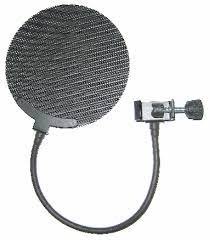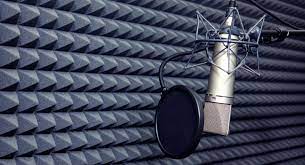You must have gotten a nice microphone and are ready to start recording, but the problem is that you keep getting weird B and P sounds each time you make a recording. Do you think you settled for a bad microphone? Do you think there is something wrong with your audio interface?
Do you think there is something wrong with your home’s acoustic treatment? Whatever the reason for the sounds you keep getting, you need to figure out how to solve the problem as soon as possible.
What is a pop filter and why you need one is what this review is out to address, so we encourage you to keep reading this guide which has so many answers to all the questions you have?
Content Navigation
What Is A Pop Filter?
Pop filters are small, usually circular, sections of metal and mesh material that most singers place in front of their microphones when trying to make a recording. Singers use the pop filter, but engineers can also use it, but microphones are designed to come with these pop filters.
The microphones that come with this pop filter are consumer microphones, and this tells you a professional microphone doesn’t come with pop filters.
Eliminating plosive B and P sounds is what the pop filter is designed to do, and it either gets rid of these sounds or reduces them. You need to have good knowledge of how microphones work if you want to get the hang of working or using a pop filter, and microphones come with thick capsule materials on the inside that tends to react to sound vibrations that travel through the air.
When these vibrations hit, the membranes move back and forth just like airwaves, but let us put a speaker in the picture right now. When music is played through a speaker, the speaker moves forward and backward, and the speaker acts based on the air around it, making it easy for you to hear what the speaker is playing.
This is the same way or method a microphone membrane works, but the only difference is the microphone membrane works backward. Air vibrations move around the membrane, which gets converted to electrical signals using the transduction form.
You don’t have to know too much about a transducer element, but all you should know is air works on the membrane, which we call the diaphragm.
Imagine a sudden flow of high-pressure air pushing the diaphragm more than its limit; this is similar to when the low end is pumped too much into the speaker. It makes the speaker start to produce distorting and clapping sounds.
These distorted and clapping sounds are plosive B and P sounds, and the rush of pressure from the lips that rapidly break hits the membrane in a way that isn’t right, leading to the production of terrible and poor sounds. These sounds are hard to get rid of when recording.
What Is A Pop Filter And Why You Need One

The importance of the pop filter is to break away airflow that is responsible for creating these plosive sounds, so when they approach the mic capsule, all of the pressure would have faded and evened out.
This makes sure you do not notice any pop sounds when making a recording, and this is why every pop filter is required for all types of singers.
It will interest you to know that all pop filters are not made using the same materials or designed to be the same, but what you need is the mesh filter. The mesh filter uses a polyester or cotton material which is effective for breaking up the airflow.
Pop filters are affordable, effective, and lightweight, while the other type of filter available on the market apart from the mesh pop filter is the metal filter.
The metal filter might be old, but they are effective in doing a good job. However, people do not trust the metal pop filters because sound engineers complained that the metal pop filters are responsible for creating a few light frequencies.
However, metal pop filters are a bit more expensive than mesh pop filters. There is something called the windscreen that is a bit similar to pop filters, and they are designed using foam that will easily glide over a microphone grille rather than stay fixed on it.
The concept behind designing the windscreen is blocking out wind when making a recording, and trust us when we say this pop filter is very effective. However, before enjoying all the benefits that come with using a pop filter, you must first learn how to set up a pop filter on a microphone.
So many pop filters on the market are designed to be attached to a gooseneck while its clamp stays at the end, and the clamp should be positioned on the microphone stand and tightened. Then, you should adjust the gooseneck so the pop filter gets to sit right in front of the microphone’s capsule.
When installing a pop filter on a microphone, ensure it is attached few inches away from the microphone itself. This is vital if you do not want to start getting weird sounds produced as a result of the pop filter rubbing against the microphone’s grille.
You will have the proper positioning if you maintain a certain distance between the pop filter and the microphone grille.
Final Note – What Is A Pop Filter
You will agree that pop filters are very simple and easy to devices on microphones, and you can also see how they can transform all of your recordings amazingly.
Pop filters have proved to be the essential part of every studio setup, so you must go ahead and grab one or two for all of your recordings.
Now that you have seen the benefits of these pop filters, you have no excuses not to get anyone for your recordings.
Related Posts
Best Budget Wireless Surround Sound System
How To Connect Speaker Wire To TV
Wireless Vs. Wired Surround Sound Speakers

